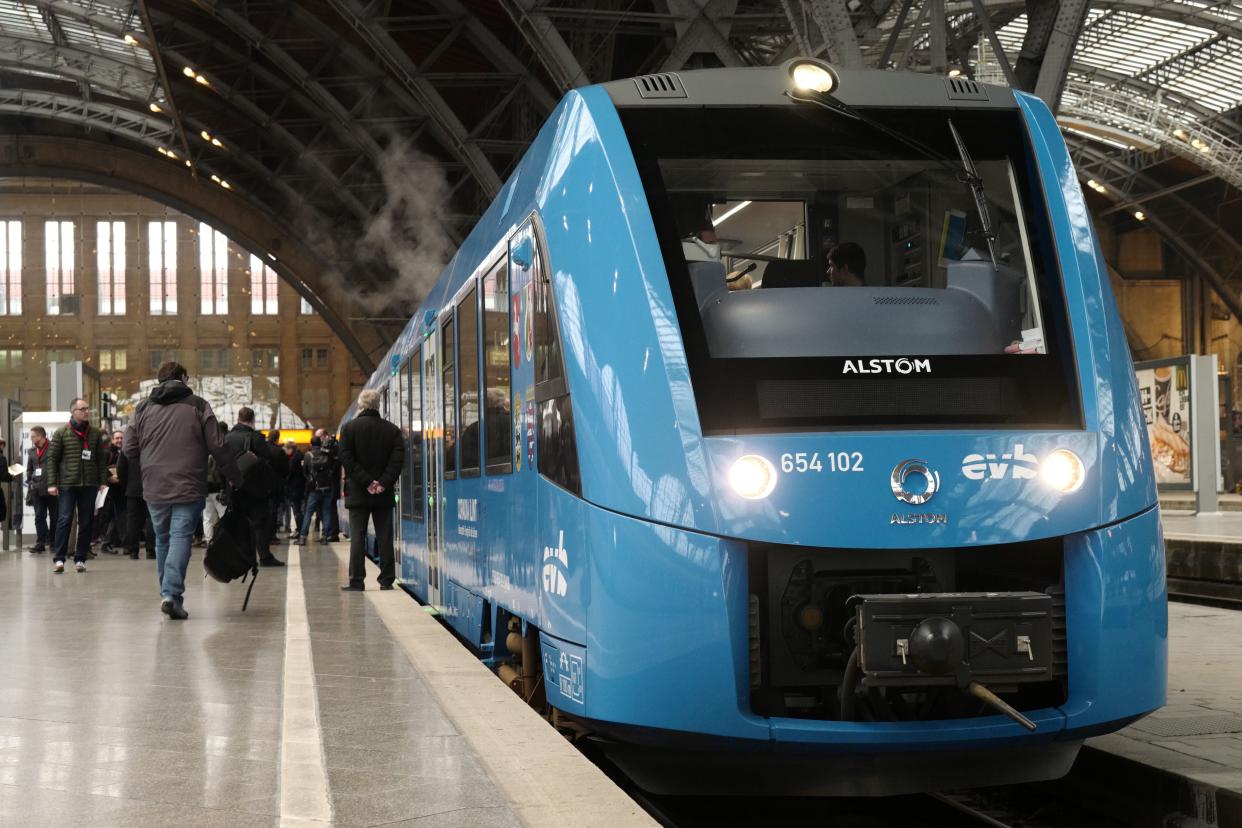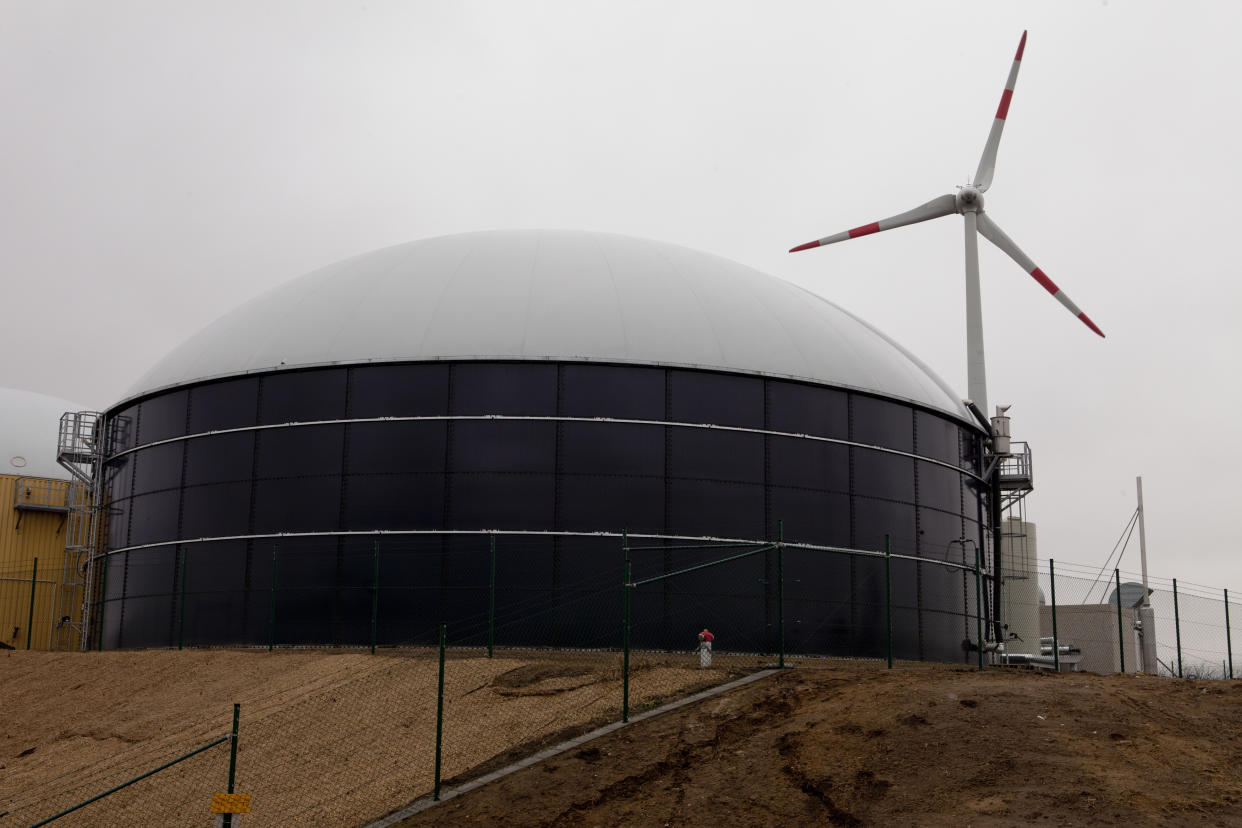To fight climate change, Europe bets big on hydrogen power but questions remain

On Wednesday, a dazzling light show of swirling windmills and dancing suns projected onto the Eiffel Tower announced France’s entry into the hydrogen age with the words “Le Paris de l’hydrogène” flashing in blue at the tower’s base.
“For the first time in history, the Eiffel Tower was lit with hydrogen!” tweeted French finance minister Bruno Le Maire. And the show itself, which culminated in the tower being illuminated in a brilliant lime hue, was powered by green hydrogen, the type made from wind and solar power, which is in short supply.
But not everyone was happy. International hydrogen expert Michael Liebreich, founder of energy research group Bloomberg New Energy Finance, slammed the display as one of the “stupidest things” he’d witnessed because of the light show’s gross inefficiency.
“They took electricity and generated hydrogen, with a 50 percent [energy] loss, then used the hydrogen to generate electricity with another 25 percent loss, and then lit up the Eiffel Tower — they literally took electricity to make the hydrogen to make electricity with a 75 percent loss — just to be able to say that they’ve lit up the Eiffel Tower with hydrogen,” Liebreich told Yahoo News.
While many in the European Union have hailed hydrogen power as a solution to the climate change crisis, the best uses for green hydrogen from renewable sources are being hotly debated in the continent’s push to transition to a scarce and currently expensive resource as a replacement for carbon-based energy, Liebreich said. That hasn’t stopped the EU from putting over $500 billion on the table to fund green hydrogen projects.
As a commodity billed by some as nothing short of the savior of life on Earth, hydrogen has quickly risen to become seen as the energy source of the future.
“Simply put, you can’t reach climate change objectives if you don’t use hydrogen,” former EU energy commissioner Andris Piebalgs, who researches hydrogen's potential at the Florence School of Regulation, told Yahoo News.
Made by electrolyzing water and separating out the oxygen, green hydrogen is currently so expensive to produce, requiring huge amounts of renewable electricity, that it is called “the champagne of the energy transition,” said Felix Heilmann, an energy researcher in E3G's Berlin office.
Employing hydrogen to power cars or even trains, Heilmann said, is like pouring a bottle of bubbly in a lake, “and saying, ‘I’ve made the water a bit fancier,’ but you also wasted the champagne.”
Yet employing low-carbon forms of hydrogen is a central plank in Europe’s plan to reduce greenhouse gas emissions by 55 percent over 1990 levels by the year 2030, and will increasingly play a role if the continent can achieve its bigger goal of net zero emissions by 2050.
“We need hydrogen for certain things that require giving energy in a gas form or liquid form,” American economist Jeremy Rifkin, author of “The Hydrogen Economy,” told Yahoo News, specifying “the industries that require a huge amount of heat, like steel and cement. We’re also going to need it for certain forms of transport” — such as long-haul trucks. “Sixteen-wheelers,” he predicts, “they’re all going hydrogen.”

As the 2002 publication date of Rifkin’s book attests, the idea of transitioning to green hydrogen as a way of weaning the world off its dependence on carbon-based sources of energy is not new.
“We’ve seen waves of interest in hydrogen before,” said Washington, D.C.-based Nicholas Kumleben, hydrogen specialist at Greenmantle, a geopolitical advisory firm. “What makes me a lot more confident in it this time around is the political support for it, especially in Europe.”
And that support only grew when earlier this month, the International Energy Agency told countries around the world to halt all new investment in fossil fuels. The IEA also recommended the “immediate and massive deployment of all available clean and efficient energy technologies,” including low-carbon types of hydrogen, and urged “a major global push to accelerate innovation.”
Europe was ahead of that curve. Solar and wind energy already provide about a third of the electricity continent-wide, and numerous hydrogen power projects have popped up over the past year. But debate still rages on the question of whether Europe can produce enough hydrogen to meet its energy goals and what activities green hydrogen should power.
Falko Ueckerdt, senior scientist at the Potsdam Institute for Climate Impact Research, warns that “for the next 10 to 15 years [green] hydrogen will be really, really scarce” and that it is not a one-size-fits-all solution. There’s no case for using it for things like cars, trains, home heating and other applications where direct electricity can do the job, Ueckerdt said. The institute recently released a much-lauded report, showing green hydrogen’s usefulness in activities like chemical and steel production, shipping and other hard-to-decarbonize sectors.
“There are four or five absolute no-regret, must-have hydrogen sectors,” Ueckerdt said, and “they’re sucking all the hydrogen supply by themselves.” Liebreich concurs, and is so adamant about what applications are appropriate that he’s created a hydrogen hierarchy ladder, often referenced by energy experts.
As the hydrogen craze proliferates, that scarcity is sure to increase. At present, hydrogen from wind power is being made atop former oil rigs in the North Sea, and new plants to make it are being built in Spain, one large electrolyzation plant being a Saudi Aramco co-venture with the Spanish utility Iberdrola. Across the Iberian peninsula, upcoming projects from ceramics factories to Barcelona's bus system will be powered by hydrogen. Hydrogen fuel-cell trains glide through German forests and past French vineyards. Known as a “hydrogen village,” Winlaton, England plans to pipe in hydrogen to power everything from heating to stoves.
A wholesale transitioning to hydrogen power also means retrofitting existing pipelines, another expensive venture, and pumping hydrogen to homes and cities also carries safety risks.

“That is not safe,” Justin Mikulka, author of “Bomb Trains,” said of the prospect of creating hydrogen villages and converting pipelines. “Those were not designed to be used for hydrogen. And so everything has to be retrofit, or you’re going to be looking at leaks in buildings, which is the last thing you want, because hydrogen is very flammable.”
Still with carbon emissions continuing their steep rise and global temperatures poised to rise above the 1.5 degree Celsius threshold beyond which scientists warn the planet will suffer myriad devastating consequences, green hydrogen continues to be seen as part of the solution.
“Hydrogen definitely has an important role to play in EU energy, decarbonization and achieving climate neutrality by 2050,” said Eleonora Moro of E3G’s Brussels office, who with Heilmann has published fact sheets for the hydrogen-curious public. “But it isn’t the green savior or the silver bullet that it’s being portrayed in many contexts.”
Critics of the push toward hydrogen power say that the urgency of doing so is being hyped by lobbyists for the industry.
“What the hydrogen lobby wants, and the European Commission and national governments are facilitating, is to create a huge market for hydrogen,” said Belén Balanyá of watchdog group Corporate Europe Observatory, which recently documented the gas industry’s lobbying efforts in expanding the hydrogen market. “They are inflating the need so much, that if it goes their way will be hugely problematic.” The hydrogen lobby, of which Hydrogen Europe is a leader, “managed to build an impressive pipeline of projects that they wanted to build,” said Gniewomir Flis, senior hydrogen adviser for German think tank Agora Energiewende. That began in earnest in December 2019, when the EU unveiled the European Green Deal. “They just swooped in and said, ‘Hey, you’re looking for a green recovery. You’re looking for deep decarbonization.’ And they sold the story where Europe can become a leader in renewable hydrogen. ‘Look how many projects we have here. Just give us the money and the permits, and we’ll get to work.’”
Over the coming years, as society transitions away from fossil fuels, electricity from wind and solar required to make green hydrogen could become a scarce commodity, said Urs Maier, senior associate in energy and infrastructure at Berlin-based Agora Transport Transformation. “So we need to use that electricity as efficiently as possible, which is why we are saying that everywhere where you could use electricity directly [instead of using the electricity to make green hydrogen], you should really do that,” Maier said.
With hydrogen commuter trains being increasingly utilized to connect the backwaters of Western Europe, Maier believes that's not the optimal route, since trains would be more efficient if electrified or battery-powered. “Hydrogen trains need at least twice as much electricity per kilometer as you need using electricity from batteries,” he said.
While there’s plenty of optimism about making the leap from fossil fuels to renewable sources of energy, the consensus among critics is that green hydrogen, while certainly an important factor in Europe’s energy mix, shouldn’t be touted as the answer to climate change.
“Hydrogen proponents often highlight its versatility by comparing it to a Swiss Army knife of decarbonization,” said analyst Flis of Agora Energiewende, adding, “Swiss Army knives can be useful, but for complex problems, purpose-built tools are better.”
____
Read more from Yahoo News:


